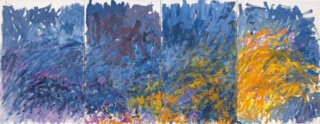When Irving Sandler asked Joan Mitchell what she felt about the word ‘nature’, she didn’t mince her words: ‘I hate it. It reminds me of some Nature-Lover Going Out Bird-Watching.’ It was 1957 and Sandler was interviewing Mitchell in her fourth-floor walk-up on the Lower East Side. Mitchell’s gestural paintings were admired for their glowing abstraction, suggestive of landscapes, but she was reluctant to let clichés about the natural world attach themselves to her work. Frank O’Hara sent a letter within days of reading the interview, to congratulate ‘ma Baudelairienne actuelle’ on the central picture, George Went Swimming at Barnes Hole, But It Got Too Cold, which he said he longed to see again. He was too late, however. Mitchell was already back at her studio in Paris.
As a young painter she had been part of the New York art scene of the late 1940s; she was a member of The Club and hung out at the Cedar Tavern (where, she said, painters were forever ‘yak-yak-yakking about blah-blah-nothing’). In 1948 she won a travelling fellowship from the Art Institute of Chicago, which allowed her to visit France. She went back and forth for a decade before settling permanently in 1959, first in Paris and then in the village of Vétheuil, about forty miles away. Her studio was surrounded by greenery and looked down on the Seine – she is said to have asked the gardener to use scissors to cut the lawn in order to protect the dandelions – and it was here that she painted her vast polyptych canvases. Right up until her death in 1992 she remained committed to what she liked to call ‘AEOH’ – Abstract Expressionist Old Hat. The recent retrospective of her work, jointly organised by the San Francisco Museum of Modern Art and Baltimore Museum of Art, and on view at the Fondation Louis Vuitton in Paris until 27 February, sweeps away the self-effacing acronyms.
‘I want to make myself available to myself,’ Mitchell explained to Sandler, as she described her intuitive process. She would begin by sketching charcoal forms onto unstretched canvas, then proceed to layer paint in her distinctive palette. Elsewhere she spoke of the release of painting, comparing it to riding a bicycle with no hands. She wanted to evoke the particular ‘feeling’ certain places held, stepping back to study the effect of each brushstroke (‘it’s a lot of walking’), and used concave glass to see the way a painting would look from afar. Close up, a work such as the 7.5-metre-long Edrita Fried (1981) is a thunderous panorama. Or as Eileen Myles describes it in one of her poems for the catalogue: you can get drunk on its ‘raucous heft’.
Mitchell’s mother, Marion Strobel, was a poet and associate editor of Poetry magazine; as a girl, Mitchell met T.S. Eliot, Edna St Vincent Millay, Dylan Thomas, Ezra Pound and others. The exhibition opens with works from the 1950s, including Hemlock (named after a line from a Wallace Stevens poem) and Evenings on 73rd Street, both a mass of densely worked strokes against a nimbus of white paint, like scrawled writing on a piece of paper. John Ashbery described the way her ‘calligraphy, sometimes flowing, sometimes congealing, continues patiently, as though in a long letter to someone’. Mitchell was briefly married to Barney Rosset, who ran Grove Press, and she became almost a patron saint to the New York School poets. In O’Hara’s letter, he mentions ‘your ardent admirer Jimmy Schuyler’, whose poems she turned into pastel drawings, flurries of colour above his short typed stanzas:
The mint bed is in
bloom: lavender haze
day. The grass is
more than green and
throws up sharp
cutting lights to
slice through the
plane tree leaves. And
on the cloudless blue
I scribble your name.
Mitchell’s paintings are distinctive (one reason her work enjoyed market success from the first), but the exhibition’s chronological hang reveals an evolution. The bracken of marks, painted with flat hog-bristle brushes in the 1950s, takes on more complex, experimental textures in the 1960s, as paint is daubed and flicked and smeared, before a new exuberance arrives in hovering swatches of colour, and then a loosening of brushwork and an expansion of scale in the 1980s. Through all this, painting thick and thin, she sustained a lightness of touch. She worked slowly and judiciously, and was ruthless about canvases that failed to meet the mark, saying that she had ‘great morgues of paintings’ in her cupboards.
In later life, Mitchell was cantankerous and disliked being asked about her relationship to French Impressionism, especially Monet. This could hardly be avoided given that she lived on avenue Cl. Monet and looked out over the cottage where he had lived from 1878 to 1881. When Deborah Solomon visited in 1991 for an article for New York Magazine, Mitchell was quick to say that she had bought the house ‘because I liked the view, not out of any love for Monet’ – pronouncing his name ‘so that it rhymes with the word “bonnet”’. This makes it all the more intriguing that the Fondation Louis Vuitton has accompanied her retrospective by a second exhibition, over several floors, pairing her work with late paintings by Monet. Must an American woman have a French man to chaperone her in the museum?
It’s true that the addition of Monet lends the show a blockbuster status Mitchell alone couldn’t achieve. (Their alliterative surnames are not given in alphabetical order.) But there is more to it than that, since Mitchell protested rather too much against the comparison with Monet. Perhaps she found it tiresome rather than untrue. As a child, she said, she had been so thoroughly immersed in the Impressionist collections at the Art Institute, which at the time owned more than twenty Monet paintings, that she thought ‘all painting was French’. When Solomon persisted with her line of questioning, Mitchell reluctantly got down her Monet catalogue raisonné and flicked through the pages from his later years. These were the works that had been most successful in the US, after MoMA’s acquisition of one of the Nymphéas in 1955. The following year Clement Greenberg published his essay ‘The Later Monet’, which described Monet’s move towards an immersive foreground as a precursor to large-scale American abstraction.
What is exceptional about the accompanying exhibition at the Fondation Louis Vuitton is the lengths the curators have gone to to establish a correspondence between canvases made at least a half century apart. Almost all the Monets have been taken out of their frames (something the lenders must have been reluctant to allow), creating a sense not of influence but of shared attention: to the dewiness of foliage, the quality of light on still water, the inchoate energy of garden flowers. Mitchell reinvigorated the legacy of Monet’s late work but in ways that were distinctively her own, so it’s a pleasure to see that the final room has been given over entirely to her Grande Vallée paintings. A bench in the middle allows you to sit and drink in their terrific, raucous heft.
Send Letters To:
The Editor
London Review of Books,
28 Little Russell Street
London, WC1A 2HN
letters@lrb.co.uk
Please include name, address, and a telephone number.


